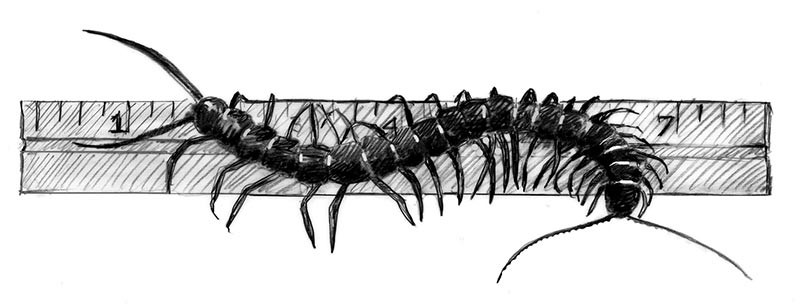
Biologists sometimes field questions about a “huge scary bug” that appeared in someone’s home or worse yet on their person. Most turn out to be benign organisms that ended up in the wrong place. For me, the most common questions come in July, when male dobsonflies emerge from the Winooski River and often end up crashing into windows on the Saint Michael’s College campus where I teach. The males have impressive mandibles that look scary but are harmless to people.
Recently however, one of these questions did actually involve something dangerous. One morning I received a call from a friend and grade school teacher, who explained that she had managed to corral a very large and intimidating centipede in a plastic container at her school. I immediately emailed her a photograph of a house centipede, fully expecting that to be the end of the discussion. House centipedes commonly attract the attention of teachers and home owners. They frequently get trapped in the sink at my children’s school, and I discreetly liberate them so that they can eat real pests. However, in this case, “house centipede” was not the correct answer. I asked if the arthropod was slow moving and dark, thinking that perhaps she had found a stranded hellgrammite. No, she said, it was fast.
This was getting interesting!
My friend described a centipede that was black and orange at the front, with a forked “tail” and yellow legs. Its most surprising feature was its size, a full six inches long. At this point, I asked for a photograph because the insect sounded like nothing I had encountered in Vermont. From the photograph, I determined that it was most likely a giant desert centipede (Scolopendra heros). That settled the first question, but left still many others unanswered. The school principal wanted to know if the centipede was dangerous. Were there likely to be more lurking about? Should he shut down the classroom? How does a desert centipede end up in Vermont?
I reassured them that it was unlikely to find even one such centipede in Vermont (and then less reassuringly suggested that, because one was found, they keep their eyes open). I informed the state entomologist and sent him photographs. I learned that desert centipedes give particularly nasty bites. In some cases, they can cause renal failure and even death. While death by centipede isn’t a common way to go, even in the desert, this species was certainly due some respect.
I guessed that the centipede may have come up from the desert southwest in packaging material, or perhaps through the pet trade. The truth was more surprising.
The school in question, like many Vermont schools, uses a children’s book called Flat Stanley to combine reading skills with art, geography, and just plain fun. Because Stanley is flat, he can be mailed in an envelope, and many children in schools across the world make their own Flat Stanleys and send them to friends in other places. Their friends photograph Stanley in interesting locations and return him along with local souvenirs. When my son did this, we sent Stanley to Ireland, Cyprus, and Australia.
Stanley was sent by my friend’s student to an aunt in Texas, and she mailed him back with Texas souvenirs. The package included a map of Texas, a length of rope representing the horn span of a Texas longhorn, a piece of prickly pear cactus, and a Ziploc® bag with a hole chewed in the corner labeled, “DO NOT TOUCH – CENTIPEDE.”
Why one sends a dangerous centipede (or any centipede) through the mail is a mystery, but it certainly happened. While I can’t imagine that this centipede would establish in Vermont even if dozens were sent, it underscores the continuing need to educate the public about the dangers of moving species to new locations. On a positive note, the school has added the now dead, preserved centipede to its invertebrate collection for classroom use. I think that speaks very well for the school that the students will learn valuable lessons from Flat Stanley’s travel companion. Perhaps it will inspire some budding entomologists?


Discussion *